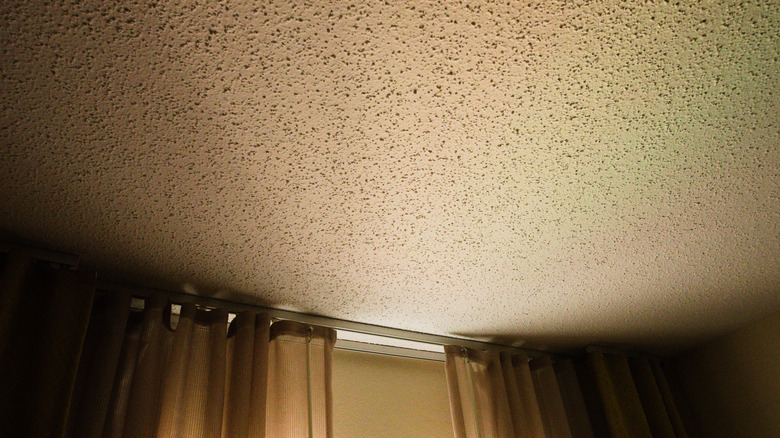Don't Panic: What To Do If Your Popcorn Ceiling Starts To Sag
Looking up and seeing a misshapen, sagging ceiling can definitely be panic-inducing, especially when you are aware of the hidden danger that may be lurking in popcorn ceilings. Whether it seems like the ceiling is about to cave in or like your house has simply seen better days, a sagging ceiling is a problem worth addressing, as it can point to underlying issues. So, if you notice that your ceiling is drooping down in an area, some concern is definitely normal and warranted. Luckily, though, you don't need to completely panic about repair costs, extensive damage, or the frightening look of it just yet. While ceiling sags can have a wide range of causes, it is not always a major issue. In some cases, you can resolve the issue and get your ceiling back in place fairly easily by using drywall screws and adhesive, but you will need to keep your ceiling's texture in mind to make sure your repair is safe.
If your ceiling is sagging, the first thing you need to do is determine the cause. This will help you make sure you choose the appropriate solution and ensure that a persisting problem doesn't quickly ruin your repair. Some of the most common causes of sagging ceilings are related to movement that affects your home's structure, inadequate support, moisture, and deterioration from age. Moisture and age can both be a bit more difficult to deal with, as moisture and structural damage can be extensive and older popcorn ceilings are more likely to contain asbestos, which can be dangerous to fix on your own and will require a professional.
Determining the cause of a sagging popcorn ceiling
If you are unsure whether or not your popcorn ceiling contains asbestos, you should call a professional immediately if the ceiling begins to sag. Popcorn ceilings constructed between the 1950s and mid-1980s are likely to contain asbestos, so some homes today may still be dangerous. A sag in the ceiling indicates a breakdown of the ceiling material, which means asbestos is likely being released. Breathing in or consuming asbestos is associated with deadly diseases, even with most face coverings you are likely to have at home, so you should call someone qualified to safely test for asbestos before doing anything else if you have any doubts.
If you are certain that your popcorn ceiling does not contain asbestos, start with a careful visual inspection. Look for water damage, the location of the sag, and worsening over time. If moisture is the culprit, you are likely to see discoloration, cracking, peeling, bubbling, or even water. Moisture-related sags are likely to be localized to just one part of the ceiling, but moisture can also spread and be visible on nearby walls. Sagging caused by moisture is an urgent problem that could lead to a dangerous collapse, so you should leave the area and quickly call a professional.
Structural issues are also a cause for concern. They can occur due to shifting of the house, termites, and improper installation. These sags will have no sign of liquid, but you may see cracking. You should also evacuate the area for structural issues, as they can lead to unsafe collapses.
Fixing a sagging popcorn ceiling
Finally, the sag may look like a long, even bow across the ceiling. This type of sag is common on old ceilings. Adhesives and other ceiling materials can age and deteriorate over time, leaving you with a droop. If there are no signs of water damage, then this may be one of the few that is relatively easy to fix on your own. By adding new nails and screws, you can reattach and tighten the ceiling in place. Then, if needed, fix your peeling popcorn ceiling so it looks good as new.
Unfortunately, for most cases of sagging popcorn ceilings, you will need to call in a professional. Sagging often means that a problem is severe and unsafe. So, hiring someone who can fix everything and ensure that your home is structurally safe is important. A relatively simple structural fix for something like improper installation or issues resulting from movement of the house can cost between $500 and $1,500.
For a moisture-damaged ceiling, depending on how much water and damage there is, this is likely to cost between $800 and $2,500, but could climb to as much as $10,000. This should include fixing the leak or other water issue as well. If you believe you can safely find the source of the water and stop it, then you could potentially do this project yourself before following the correct way to repair water damage on popcorn ceilings to get your ceilings looking nice again. No matter what the issue is, be sure to act quickly and avoid panicking to get the problem resolved quickly and safely.


